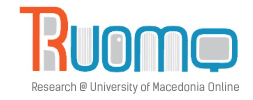Please use this identifier to cite or link to this item:
https://ruomo.lib.uom.gr/handle/7000/744| Title: | Price discount facility in an EOQ model for deteriorating items with stock-dependent demand and partial backlogging |
| Authors: | Shaikh, Ali Akbar Khan, Md. Al-Amin Panda, Gobinda Chandra Konstantaras, Ioannis |
| Type: | Article |
| Subjects: | FRASCATI::Natural sciences::Mathematics FRASCATI::Social sciences::Economics and Business |
| Keywords: | EOQ deterioration all-units quantity discount stock-depended demand linearly time‐varying carrying cost partial backlogged shortages |
| Issue Date: | 2019 |
| Publisher: | Wiley |
| Source: | International Transactions in Operational Research |
| Volume: | 26 |
| Issue: | 4 |
| First Page: | 1365 |
| Last Page: | 1395 |
| Abstract: | All‐units discount facilities are one of the attractive features in the competitive business situation. Due to the globalization of the marketing policy, all‐units discount facilities play an important role in the competitive business. Typical economic order quantity (EOQ) models are cloistered by considering as constant not only the purchase cost (irrespective of the order size of the product) but also the carrying cost during the entire cycle period. However, the unit purchase cost has an antagonistic relationship with the order size, and the carrying cost has a commensurate relationship with the storage time‐period of the product, that is, the higher the order size, the lower the unit purchase cost, and the longer the storage time‐period, the greater carrying cost per unit. Also deterioration is another imperative issue in inventory analysis as it has a huge impact on profit or cost of the inventory system. Considering all of the above‐mentioned factors, we study two different inventory models, namely (a) inventory model for zero‐ending case and (b) inventory model for shortages case. The demand for both models is considered as price and stock dependent, whereas shortages are partially backlogged at a rate with the length of the waiting time to the arrivals of the next lot. The existence and uniqueness of the optimal solution for both models are examined theoretically and the solution procedures are discussed along with two proposed algorithms for minimizing the total cost. Finally, we perform sensitivity analyses for both models and make a fruitful conclusion regarding the proposed work. |
| URI: | https://doi.org/10.1111/itor.12632 https://ruomo.lib.uom.gr/handle/7000/744 |
| ISSN: | 0969-6016 |
| Other Identifiers: | 10.1111/itor.12632 |
| Appears in Collections: | Department of Business Administration |
Files in This Item:
| File | Description | Size | Format | |
|---|---|---|---|---|
| ITOR accepted paper.pdf | Paper published in ITOR | 449,51 kB | Adobe PDF | View/Open |
Items in DSpace are protected by copyright, with all rights reserved, unless otherwise indicated.
